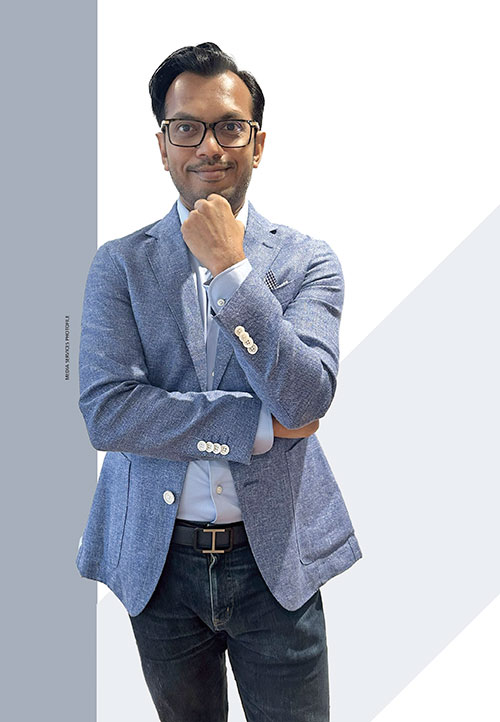HOME DECOR SECTOR
Compiled by Yamini Sequeira
SHAPING CONSUMER TRENDS
Uditha Illeperuma stresses the importance of decor that shapes modern lifestyles
Q: What trends are currently shaping consumer preferences in the home decor and interior design market in Sri Lanka?
A: The popular trend prevalent at this time is modern Italian, which pivots away from the opulence of neoclassical and contemporary styles. Preference for natural and fibre leather are also growing, characterised by rich textures, modern finishes and durability.
Moreover, the modern minimalistic style is enhanced by adding unique personalised pieces. In essence, consumers seek furniture that is aesthetically pleasing, durable and tailored to their individual needs. Open concept layouts and minimalist designs are also gaining traction, particularly in urban areas.
There is also a growing emphasis on creating spaces that promote wellbeing with features such as neutral colours, whites and soothing textures with a modern edge. Many young upwardly mobile professionals, especially those who have experienced global living, are increasingly drawn to quality, design and lifestyle expressions.
Given the evolving lifestyles and fast moving trends, consumers seek to keep pace with international style trends of subtle luxury, lasting sophistication and value for money.
Q: Are Sri Lankan consumers more design conscious when it comes to furnishing and decorating their homes?
A: With a growing preference for modern, stylish and durable options that blend modern aesthetics with luxurious design elements, Sri Lankan consumers are moving beyond purely functional furniture, and seeking pieces that are both aesthetically pleasing and reflective of their personal styles.
Evolving lifestyles have led to a greater emphasis on quality, durability and design when it comes to home furnishings.
Wall coverings with subtle textures that add character are popular – i.e. as opposed to plain walls. Lighting solutions that enhance ambience along with lush carpets and modern accessories are also in demand.
Q: How has the demand for locally crafted home decor items evolved? And are customers leaning more towards artisanal or imported goods?
A: There is a selective demand for locally crafted pieces; however, there’s more interest and rising demand for imported furniture and furnishings from Asian manufacturers. This is due to the variety of materials, design elements and high quality finishes available.
Superior levels of attention to detail and craftsmanship play a pivotal role in consumers choosing imported goods, especially when these can be tailored to meet personalised design needs at more affordable prices.
The opportunity to have any piece of furniture customised to the same level of detail and high quality desired by customers is another discerning factor behind this shift.
Recognising this need, suppliers of home decor products and services are offering flexibility for customers to personalise products to their space requirements, while keeping abreast of latest trends and modern designs.
Q: What role do online platforms and social media play in influencing home decor purchasing decisions?
A: Interior designers and retailers are leveraging online platforms, to showcase their products and services to reach a wider audience.
Although online shopping is growing in popularity due to convenience and accessibility, there remains a strong demand to physically touch and feel luxury goods and fine furnishings.
Many local consumers prefer the latter due to negative experiences they’ve encountered by trusting content on social media, where they may have been misled by purchasing products that doesn’t match the images.
Therefore, customers should engage with design companies with strong reputations, and proven track records of consistency in their products and services.
Q: What shifts have you observed in consumer shopping behaviour?
A: Consumer behaviour in Sri Lanka has evolved extensively, especially in the luxury segment.
Purchases are now driven not only by utility but also social status, prestige and self-image. Luxury goods in particular are strongly influenced by the desire to project sophistication and exclusivity.
Consumers are seeking to create living and personal spaces that are modern, practical and luxurious.
Interestingly, price is often prioritised over quality at present, largely due to economic pressures, resource limitations and import related constraints – such as clearance delays and tariffs – which have doubled product costs, and impacted both local manufacturers and consumers.
Economic factors such as inflation and currency devaluation have affected consumer spending and purchasing power, creating a generation of price conscious consumers. As a result of these challenges, customers have become more price sensitive and cautious in their spending habits.
At the same time, there is a marked shift towards conscious consumerism.
Many consumers favour sustainable, locally made artisanal products alongside imported goods. The demand for personalised experiences is also growing with buyers seeking products that resonate with their lifestyle and values.
Sustainability has become a defining factor. More consumers are willing to pay a premium for environmentally friendly goods and services, prioritising products with eco-friendly packaging and ethical production practices.
This shift reflects rising awareness of climate change, social responsibility and the importance of supporting developing economies.







